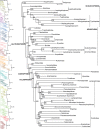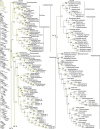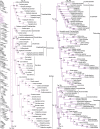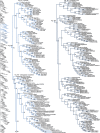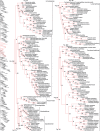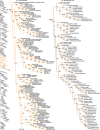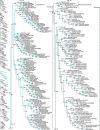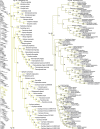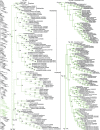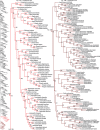A Species-Level Phylogeny of Extant Snakes with Description of a New Colubrid Subfamily and Genus - PubMed (original) (raw)
A Species-Level Phylogeny of Extant Snakes with Description of a New Colubrid Subfamily and Genus
Alex Figueroa et al. PLoS One. 2016.
Abstract
Background: With over 3,500 species encompassing a diverse range of morphologies and ecologies, snakes make up 36% of squamate diversity. Despite several attempts at estimating higher-level snake relationships and numerous assessments of generic- or species-level phylogenies, a large-scale species-level phylogeny solely focusing on snakes has not been completed. Here, we provide the largest-yet estimate of the snake tree of life using maximum likelihood on a supermatrix of 1745 taxa (1652 snake species + 7 outgroup taxa) and 9,523 base pairs from 10 loci (5 nuclear, 5 mitochondrial), including previously unsequenced genera (2) and species (61).
Results: Increased taxon sampling resulted in a phylogeny with a new higher-level topology and corroborate many lower-level relationships, strengthened by high nodal support values (> 85%) down to the species level (73.69% of nodes). Although the majority of families and subfamilies were strongly supported as monophyletic with > 88% support values, some families and numerous genera were paraphyletic, primarily due to limited taxon and loci sampling leading to a sparse supermatrix and minimal sequence overlap between some closely-related taxa. With all rogue taxa and incertae sedis species eliminated, higher-level relationships and support values remained relatively unchanged, except in five problematic clades.
Conclusion: Our analyses resulted in new topologies at higher- and lower-levels; resolved several previous topological issues; established novel paraphyletic affiliations; designated a new subfamily, Ahaetuliinae, for the genera Ahaetulla, Chrysopelea, Dendrelaphis, and Dryophiops; and appointed Hemerophis (Coluber) zebrinus to a new genus, Mopanveldophis. Although we provide insight into some distinguished problematic nodes, at the deeper phylogenetic scale, resolution of these nodes may require sampling of more slowly-evolving nuclear genes.
Conflict of interest statement
The authors have declared that no competing interests exist.
Figures
Fig 1. Abridged phylogeny on final dataset of 1652 snake species and seven outgroup taxa displaying higher-level relationships.
Maximum-likelihood phylogenetic estimate based on 10 concatenated genes. Tips represent families and sub-families. Commonly recognized higher-level clades are labeled in all caps and bold. Species classified as Lamprophiidae incertae sedis are also shown since they did not place within a subfamily. Node values represent SHL support values. Skeleton of the species tree is displayed on the left, colored and labeled as they appear in Figs 2–10.
Fig 2. Species-level phylogeny on final dataset of 1652 snake species.
Maximum-likelihood phylogenetic estimate based on 10 concatenated genes. Node values represent SHL support values. Seven outgroup taxa are not shown. Colors of clades indicate their position in the overall tree, shown at left. Newly sequenced taxa are highlighted in bold. Skeleton of the species tree is displayed on the left with displayed subfamilies/families highlighted. Letters denoted by i and ii represent parts of the tree where external branches do not connect to the part of the tree immediately preceding it. A) Anomalepididae, Epictinae, Leptotyphlopinae, Gerrhopilidae, Xenotyphlopidae, and Typhlopinae. B) Asiatyphlopinae I, Afrotyphlopinae; Madatyphlopinae, and Asiatyphlopinae II.
Fig 3. Phylogenetic tree of Serpentes continued.
A) Aniliidae, Tropidophiidae, Calabariidae, Candoiidae, Sanziniidae, Charininae, Ungaliophiinae, Erycidae, and Boidae. B_i_) Cylindrophiidae + Anomochilidae, Uropeltidae, Xenopeltidae, Loxocemidae, and Pythonidae. B_ii_) Bolyeridae, Xenophidiidae, Acrochordidae, Xenodermatidae, and Pareatidae.
Fig 4. Phylogenetic tree of Serpentes continued.
A_i_) Viperinae. A_ii_) Azemiopinae and Crotalinae. B) Crotalinae continued.
Fig 5. Phylogenetic tree of Serpentes continued.
A) Homalopsidae, Psammophiinae, Buhoma procterae, Prosymninae, Pseudaspidinae, Atractaspidinae, and Aparallactinae. B_i_) Oxyrhabdium leporinum and Lamprophiinae. B_ii_) Ditypophis sp. + Micrelaps bicoloratus and Pseudoxyrhophiinae.
Fig 6. Phylogenetic tree of Serpentes continued.
A) Buhoma depressiceps and Elapidae. B) Elapidae continued.
Fig 7. Phylogenetic tree of Serpentes continued.
A) Sibynophiinae and Natricinae. B) Pseudoxenodontinae and Dipsadinae.
Fig 8. Phylogenetic tree of Serpentes continued.
A) Dipsadinae continued. B) Dipsadinae continued.
Fig 9. Phylogenetic tree of Serpentes continued.
A) Grayiinae, Calamariinae, Ahaetullinae subfam. nov., and Colubrinae. B_i_) Colubrinae continued. B_ii_) Colubrinae continued.
Fig 10. Phylogenetic tree of Serpentes continued.
A) Colubrinae continued. B) Colubrinae continued.
Similar articles
- Genus-level phylogeny of snakes reveals the origins of species richness in Sri Lanka.
Pyron RA, Kandambi HK, Hendry CR, Pushpamal V, Burbrink FT, Somaweera R. Pyron RA, et al. Mol Phylogenet Evol. 2013 Mar;66(3):969-78. doi: 10.1016/j.ympev.2012.12.004. Epub 2012 Dec 20. Mol Phylogenet Evol. 2013. PMID: 23261713 - Resolving the phylogeny of lizards and snakes (Squamata) with extensive sampling of genes and species.
Wiens JJ, Hutter CR, Mulcahy DG, Noonan BP, Townsend TM, Sites JW Jr, Reeder TW. Wiens JJ, et al. Biol Lett. 2012 Dec 23;8(6):1043-6. doi: 10.1098/rsbl.2012.0703. Epub 2012 Sep 19. Biol Lett. 2012. PMID: 22993238 Free PMC article. - The phylogeny of advanced snakes (Colubroidea), with discovery of a new subfamily and comparison of support methods for likelihood trees.
Pyron RA, Burbrink FT, Colli GR, de Oca AN, Vitt LJ, Kuczynski CA, Wiens JJ. Pyron RA, et al. Mol Phylogenet Evol. 2011 Feb;58(2):329-42. doi: 10.1016/j.ympev.2010.11.006. Epub 2010 Nov 11. Mol Phylogenet Evol. 2011. PMID: 21074626 - Comparing species tree estimation with large anchored phylogenomic and small Sanger-sequenced molecular datasets: an empirical study on Malagasy pseudoxyrhophiine snakes.
Ruane S, Raxworthy CJ, Lemmon AR, Lemmon EM, Burbrink FT. Ruane S, et al. BMC Evol Biol. 2015 Oct 12;15:221. doi: 10.1186/s12862-015-0503-1. BMC Evol Biol. 2015. PMID: 26459325 Free PMC article. - Combining phylogenomic and supermatrix approaches, and a time-calibrated phylogeny for squamate reptiles (lizards and snakes) based on 52 genes and 4162 species.
Zheng Y, Wiens JJ. Zheng Y, et al. Mol Phylogenet Evol. 2016 Jan;94(Pt B):537-547. doi: 10.1016/j.ympev.2015.10.009. Epub 2015 Oct 22. Mol Phylogenet Evol. 2016. PMID: 26475614
Cited by
- The rise of genomics in snake venom research: recent advances and future perspectives.
Rao WQ, Kalogeropoulos K, Allentoft ME, Gopalakrishnan S, Zhao WN, Workman CT, Knudsen C, Jiménez-Mena B, Seneci L, Mousavi-Derazmahalleh M, Jenkins TP, Rivera-de-Torre E, Liu SQ, Laustsen AH. Rao WQ, et al. Gigascience. 2022 Apr 1;11:giac024. doi: 10.1093/gigascience/giac024. Gigascience. 2022. PMID: 35365832 Free PMC article. - Fangs for the Memories? A Survey of Pain in Snakebite Patients Does Not Support a Strong Role for Defense in the Evolution of Snake Venom Composition.
Ward-Smith H, Arbuckle K, Naude A, Wüster W. Ward-Smith H, et al. Toxins (Basel). 2020 Mar 22;12(3):201. doi: 10.3390/toxins12030201. Toxins (Basel). 2020. PMID: 32235759 Free PMC article. - Evolutionary history of burrowing asps (Lamprophiidae: Atractaspidinae) with emphasis on fang evolution and prey selection.
Portillo F, Stanley EL, Branch WR, Conradie W, Rödel MO, Penner J, Barej MF, Kusamba C, Muninga WM, Aristote MM, Bauer AM, Trape JF, Nagy ZT, Carlino P, Pauwels OSG, Menegon M, Ineich I, Burger M, Zassi-Boulou AG, Mazuch T, Jackson K, Hughes DF, Behangana M, Greenbaum E. Portillo F, et al. PLoS One. 2019 Apr 17;14(4):e0214889. doi: 10.1371/journal.pone.0214889. eCollection 2019. PLoS One. 2019. PMID: 30995262 Free PMC article. - Karyotype Diversification and Chromosome Rearrangements in Squamate Reptiles.
Mezzasalma M, Macirella R, Odierna G, Brunelli E. Mezzasalma M, et al. Genes (Basel). 2024 Mar 18;15(3):371. doi: 10.3390/genes15030371. Genes (Basel). 2024. PMID: 38540430 Free PMC article. Review. - A workflow of massive identification and application of intron markers using snakes as a model.
Li JN, He C, Guo P, Zhang P, Liang D. Li JN, et al. Ecol Evol. 2017 Oct 22;7(23):10042-10055. doi: 10.1002/ece3.3525. eCollection 2017 Dec. Ecol Evol. 2017. PMID: 29238535 Free PMC article.
References
- Harvey PH, Pagel MD. The Comparative Method in Evolutionary Biology (Vol. 239). Oxford: Oxford University Press; 1991.
- Huelsenbeck JP, Rannala B. Phylogenetic methods come of age: testing hypotheses in an evolutionary context.Science. 1997; 276: 227–232. - PubMed
- Pagel M. Inferring the historical patterns of biological evolution. Nature. 1999; 401: 877–884. - PubMed
- Whelan S, Liò P, Goldman N. Molecular phylogenetics: state-of-the-art methods for looking into the past.Trends Genet.2001; 17: 262–272. - PubMed
- Driskell AC, Ane C, Burleigh JG, McMahon MM, O'Meara B, Sanderson MJ. Prospects for building the tree of life from large sequence databases. Science. 2004; 306: 1172–1174. - PubMed
MeSH terms
Substances
LinkOut - more resources
Full Text Sources
Other Literature Sources
